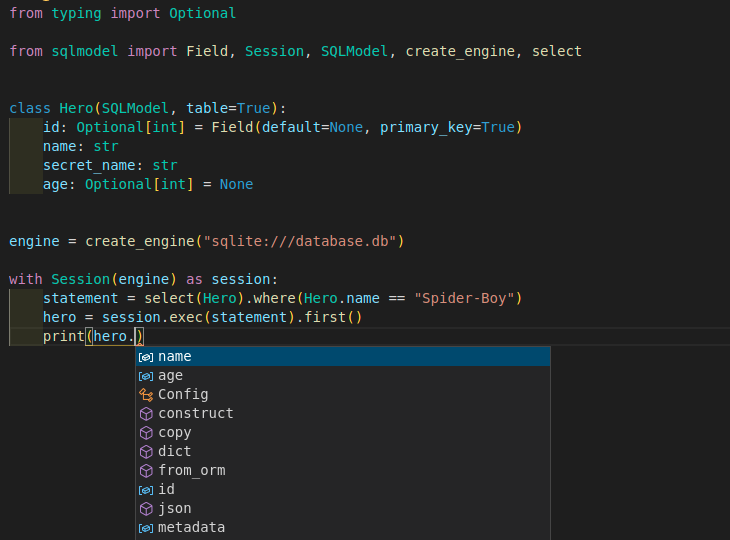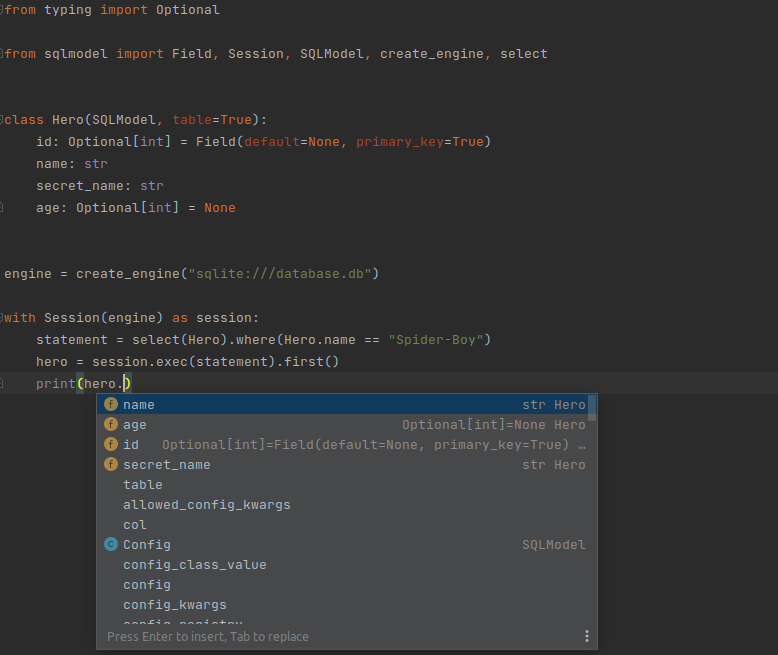Features¶
Designed for FastAPI¶
SQLModel was created by the same author of FastAPI.
It follows the same design and ideas, and it was created to be the most intuitive way to interact with SQL databases in FastAPI applications.
Nevertheless, SQLModel is completely independent of FastAPI and can be used with any other type of application. You can still benefit from its features.
Just Modern Python¶
It's all based on standard modern Python type annotations. No new syntax to learn. Just standard modern Python.
If you need a 2 minute refresher of how to use Python types (even if you don't use SQLModel or FastAPI), check the FastAPI tutorial section: Python types intro.
You will also see a 20 seconds refresher on the section Tutorial - User Guide: First Steps.
Editor support¶
SQLModel was designed to be easy and intuitive to use to ensure the best development experience, with autocompletion everywhere.
Here's how your editor might help you:

- in PyCharm:

You will get completion for everything while writing the minimum amount of code.
You won't need to keep guessing the types of different attributes in your models, if they could be None, etc. Your editor will be able to help you with everything because SQLModel is based on standard Python type annotations.
SQLModel adopts PEP 681 for Python type annotations to ensure the best developer experience, so you will get inline errors and autocompletion even while creating new model instances.

Short¶
SQLModel has sensible defaults for everything, with optional configurations everywhere.
But by default, it all "just works".
You can start with the simplest (and most intuitive) type annotations for your data.
And later, you can fine-tune everything with all the power of SQLAlchemy and Pydantic.
Based on Pydantic¶
SQLModel is based on Pydantic and keeps the same design, syntax, and ideas.
Underneath, ✨ a SQLModel model is also a Pydantic model. ✨
There was a lot of research and effort dedicated to make it that way.
That means you get all of Pydantic's features, including automatic data validation, serialization, and documentation. You can use SQLModel in the same way you can use Pydantic.
You can even create SQLModel models that do not represent SQL tables. In that case, they would be the same as Pydantic models.
This is useful, in particular, because now you can create a SQL database model that inherits from another non-SQL model. You can use that to reduce code duplication a lot. It will also make your code more consistent, improve editor support, etc.
This makes it the perfect combination for working with SQL databases in FastAPI applications. 🚀
You will learn more about combining different models later in the tutorial.
Based on SQLAlchemy¶
SQLModel is also based on SQLAlchemy and uses it for everything.
Underneath, ✨ a SQLModel model is also a SQLAlchemy model. ✨
There was a lot of research and effort dedicated to make it that way. In particular, there was a lot of effort and experimentation in making a single model be both a SQLAlchemy model and a Pydantic model at the same time.
That means that you get all the power, robustness, and certainty of SQLAlchemy, the most widely used database library in Python.
SQLModel provides its own utilities to improve the developer experience, but underneath, it uses all of SQLAlchemy.
You can even combine SQLModel models with SQLAlchemy models.
SQLModel is designed to satisfy the most common use cases and to be as simple and convenient as possible for those cases, providing the best developer experience.
But when you have more exotic use cases that require more complex features, you can still plug SQLAlchemy directly into SQLModel and use all its features in your code.
Tested¶
- 100% test coverage (currently 97%, reaching 100% in the coming days/weeks).
- 100% type annotated code base.
